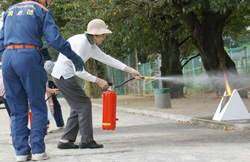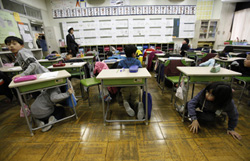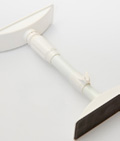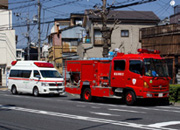Home > Highlighting JAPAN > Highlighting Japan MARCH 2013 > Disaster Prevention Drills
Highlighting JAPAN
[SERIES] STUDENTS'CORNER: Ways of Japan
Disaster Prevention Drills

A lady learns how to use a fire extinguisher at a disaster prevention demonstration

Schoolchildren crawl underneath their desks to protect themselves from falling debris during a disaster prevention drill
Credit: REUTERS/AFLO
For example, when in-school sirens sound at schools across Japan to simulate a major earthquake hitting, students all hide under their desks to protect themselves from objects falling from above. Then, the students don disaster prevention hoods (which are always kept at the ready) to protect their heads, and evacuate the premises.
Individual households also stock up on disaster prevention goods during normal circumstances in preparation for a disaster. For example, many people stockpile plastic bottles of water and foods which can be stored long-term and eaten without preparation, such as canned and retort-packed items, in case of disruption to the supply of water, electricity or gas.

Q1: The item pictured is used in the home to minimize damage due to an earthquake. What is it used for?
A. To prevent furniture from falling over
B. To prevent window glass from breaking
C. To stop people from falling down

Q2: In Japan you dial 110 to call for the police. What is the number to call for a fire truck or ambulance?
A. 119
B. 999
C. 911
© 2009 Cabinet Office, Government of Japan






